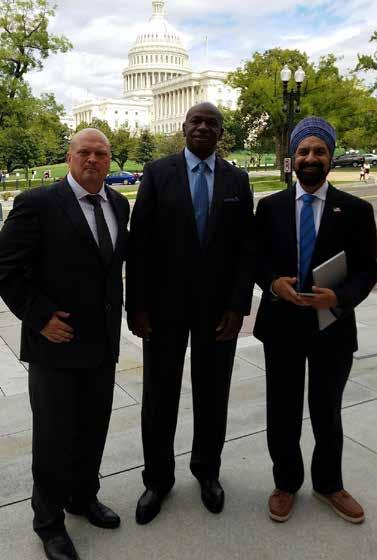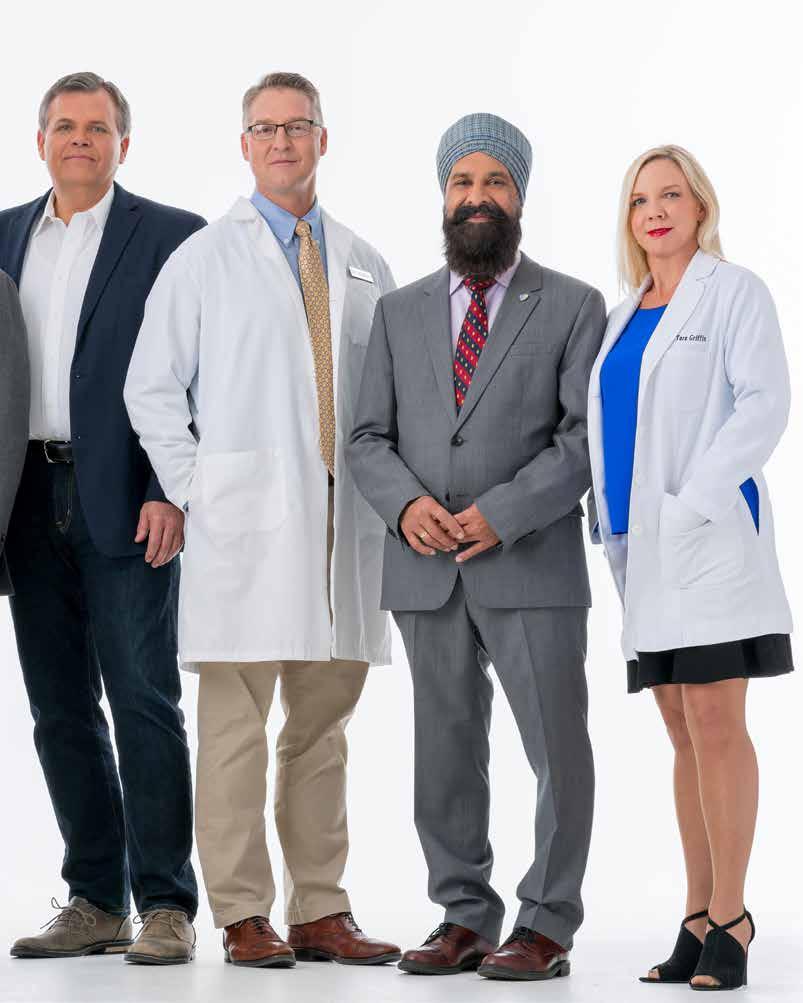
7 minute read
Upper airway remodeling: Fact or fiction?

Upper airway remodeling:
Advertisement
FACT OR FICTION?
By: Dr. G. Dave Singh DMD PhD DDSc
In 1675, Newton wrote, “If I have seen a little further it is by standing on the shoulders of giants.” In a personal communication to me in 2018, the late Dr Christian Guilleminault of Stanford University Sleep Medicine confirmed my concept that since remodeling exists with many organs it will also occur in the upper airway. It is left to us to further this particular endeavor by providing supporting evidence, but several challenges exist. For example, how can we assess airway remodeling clinically? Typically, 3D CBCT scans are used for upper airway evaluations, but for this complex, dynamic system, at least 2 Cochrane reviews suggest that current imaging modalities attempting to quantify upper airway volume changes are deficient. One of the current concerns during airway imaging is the respiratory cycle. Using protocols largely adopted from 2D cephalometry, 3D CBCT imaging protocols are not standardized, no consensus exists, and the influence of the respiratory cycle can, therefore, thwart the findings. In an early study to capture structural upper airway differences during daytime breathing, I used a different imaging technique [1] to show that airway measurements need to be taken at known phases of the respiratory cycle to produce meaningful clinical results. Therefore, professional academies and associations interested in airway, breathing and sleep issues ought to lead the initiative in some form of standardization so that treatment outcomes become comparable.

Second, there is the issue of positioning during upper airway imaging. In these instances, most 3D CBCT scans are taken with the patient either standing or sitting during wakefulness. In addition, various earplugs, chin rests, handles, etc. are used in an attempt to capture the natural head position and associated airway morphology - with various degrees of success. Some 3D scanners also come with mouthpieces, which can change the position of the mandible and/or tongue during imaging, thereby affecting the appearance of the upper airway on the final scan. Furthermore, there is some debate as to whether the patient should be imaged in the supine position to mimic sleep, even though it is known that upper airway behavior during wakefulness is distinctly differently when compared to sleeping, and some patients sleep on one side or the other, which varies during the night. To circumvent these concerns, some clinicians advocated drug-induced sleep endoscopy [2] to examine upper airway structure and function. Therefore, one of the current needs for upper airway imaging is a consensus on clinical protocol.
Even though dental specialists use 3D CBCT scanning every day, another point of discussion is that there is no validated protocol to affirm the reproducibility of images taken at T0 and T1, say, during the course of treatment. There is some evidence of CBCT-measured morphologic airway changes with surgery and oral appliance treatment for OSA [3], but currently, no valid CBCT protocol has been recognized since changes in contrast, resolution, x-ray scatter, digitizing noise, etc., can become significant, and disparate machine settings can give different results [4]. Furthermore, there is a need to develop a protocol to ensure consistent placement of anatomic landmarks before and after treatment to measure airway volume and other parameters when using 3D CBCT imaging. This lack of consistency might help explain the variability of results when reviewing and comparing changes with different treatment procedures on upper airway volumes. For example, as the magnification of a scan increases, pixilation does not, and objects that were clearly visible at low magnifications can appear to disappear on very close inspection. One method to get past these types of issues is to use edge detection algorithms to define the boundaries of the upper airway and/or other craniofacial structures of interest. We were perhaps one of the first to develop algorithms to not only render the 3D upper airway but also to do 3D printing from CBCT data [5, 6]. Moreover,
the field of mathematical modeling has grown immensely in the past decades, and geometric morphometrics, including automated landmark detection, is currently becoming available to assess clinical craniofacial changes, and might also be used to investigate upper airway morphology. Using these robust approaches, it is possible to localize and quantify allometric changes that can be verified in statistical shapespace. I believe these elegant techniques for 3D digital data will be able to address our current, legitimate concerns, and these novel concepts provide exciting avenues of further research on upper airway remodeling.
Clinically, the saving grace for dentists interested in sleep and breathing is perhaps the adaptive capability of the upper airway. It is suspected that active exercises of upper airway muscles through oral myofunctional therapy induce remodeling of the upper airway and its supporting structures [7]. This concept is not surprising since it’s generally known that exercise/workout routines can affect muscle tone and muscle mass with allied skeletal changes. Despite this contention, nasomaxillary remodeling through invasive and/or surgical approaches such as surgicallyassisted rapid maxillary expansion (SARME), mini-implant assisted rapid maxillary expansion (MARME), and distraction osteogenesis maxillary expansion (DOME) is currently in vogue. SARME involves a combination of mini-osteotomies, including pterygopalatine disjunction, prior to the use of a fixed expander to remodel the midfacial complex followed by orthodontic correction. On the other hand, MARME uses mini-screw implants that widen the hard palate and often induce pterygopalatine disjunction without surgical intervention, followed by a course of fixed orthodontics. Alternatively, DOME is somewhat similar, but it uses the phases of osteotomy, latency, distraction and consolidation to achieve skeletal correction. However, DOME is also associated with pterygopalatine disjunction (without additional surgical intervention), and relies on comprehensive orthodontic correction to close the midline diastema created using these types of protocols. Nevertheless, these three techniques are thought be at least as effective as non-surgical oral appliance therapy in the treatment of sleep disordered breathing, including obstructive sleep apnea, although significant side effects,

such as midline diastema formation, need to be addressed through orthodontic finishing, and the consequences of iatrogenic pterygopalatine disjunction are still unknown.
In any case, the Agency for Healthcare Research and Quality (AHRQ) has released its recent assessment [8], concluding that CPAP does not produce long-term, clinically significant outcomes in the treatment of OSA. Thus, the effectiveness of newer approaches requires further determination. However, the underlying patho-physiology cannot be ignored since post-surgical wound healing is dependent on stem cell differentiation [9]. Concurrently, craniofacial soft tissue moieties require simultaneous correction. Here, the concept of airway stem cells enters the discussion again. I reviewed upper airway remodeling [10] based on the premise that stems cells are distributed and localized in various regions of the upper airway, ranging from nasal epithelial stem cells [11] to basal alveolar and mesenchymal populations [12]. In fact, mesenchymal stem cell migration and adhesion, as well as endothelial repair, may be involved in the physiological responses to OSA-associated airway changes [13]. Furthermore, Machado-Júnior and Crespo [14] recently opined that maxillary expansion in adults requires further investigation in the treatment of OSA. Therefore, these mechanisms may play a role in physiologic airway remodeling, and provide fascinating avenues for further research as we emerge into a post-pandemic world.
Disclosure Dr G. Dave Singh is Founder and Chief Medical Officer of Vivos Therapeutics, Inc. He is currently collaborating with Stanford University Sleep Medicine in the development of a craniofacial facility.
References 1. Singh GD, Olmos S. Use of a sibilant phoneme registration protocol to prevent upper airway collapse in patients with TMD. Sleep Breath. 2007;11(4): 209-216. 2. Suto Y, Matsuda E, Inoue Y. MRI of the pharynx in young patients with sleep disordered breathing. Br J Radiol. 1996;69(827):1000-1004. 3. Alsufyani NA, Al-Saleh MA, Major PW. CBCT assessment of upper airway changes and treatment outcomes of obstructive sleep apnoea: a systematic review. Sleep
Breath. 2013;17(3):911-923. 4. Siewerdsen JH, Jaffray DA. Cone-beam computed tomography with a flat-panel imager: magnitude and effects of x-ray scatter. Med Phys. 2001;28(2):220-231. 5. Celenk M, Farrell ML, Eren H, Kumar K, Singh GD, Lozanoff S. Upper airway detection in cone beam images. J Xray Sci Technol. 2010;18(2):121-135. 6. Singh GD, Wendling S, Chandrashekhar R. Midfacial development in adult obstructive sleep apnea. Dent. Today 2011;30(7), 124-127. 7. Steele CM. On the plausibility of upper airway remodeling as an outcome of orofacial exercise. Am J Respir Crit Care Med. 2009 15;179(10):858-859. 8. Call for Public Review. Content last reviewed April 2021. Agency for Healthcare
Research and Quality, Rockville, MD. https://www.ahrq.gov/research/findings/ta/callfor-public-review.html 9. Bruder SP, Fink DJ, Caplan AI. Mesenchymal stem cells in bone development, bone repair, and skeletal regeneration therapy. J Cell Biochem. 1994;56(3):283-294. 10. Singh GD. Physiologic remodeling of the upper airway: Pneumopedics. J Sleep
Disord Treatment Care 7:3, 2018. 11. Wang DY, Li Y, Yan Y, Li C, Shi L. Upper airway stem cells: understanding the nose and role for future cell therapy. Curr Allergy Asthma Rep. 2015;15(1):490. 12. Almendros I, Carreras A, Montserrat JM, Gozal D, Navajas D, Farre R. Potential role of adult stem cells in obstructive sleep apnea. Front Neurol. 2012 11;3:112. 13. Carreras A, Rojas M, Tsapikouni T, Montserrat JM, Navajas D, Farré R. Obstructive apneas induce early activation of mesenchymal stem cells and enhancement of endothelial wound healing. Respir Res. 2010;11(1):91. 14. Machado-Júnior AJ, Crespo AN. Expansion of the maxilla in adults with OSAS: myth or reality? Sleep Med. 2020;65:170-171. 18 | Sleep & Wellness Magazine





